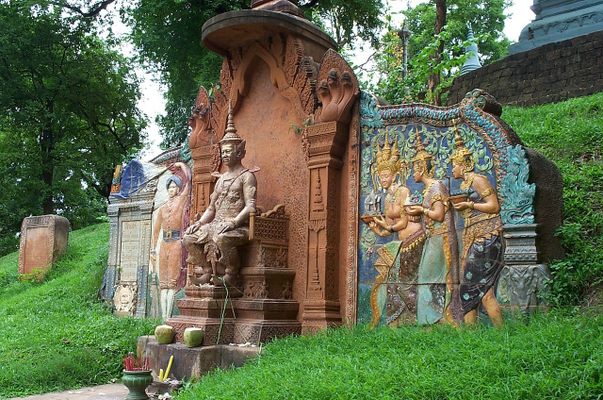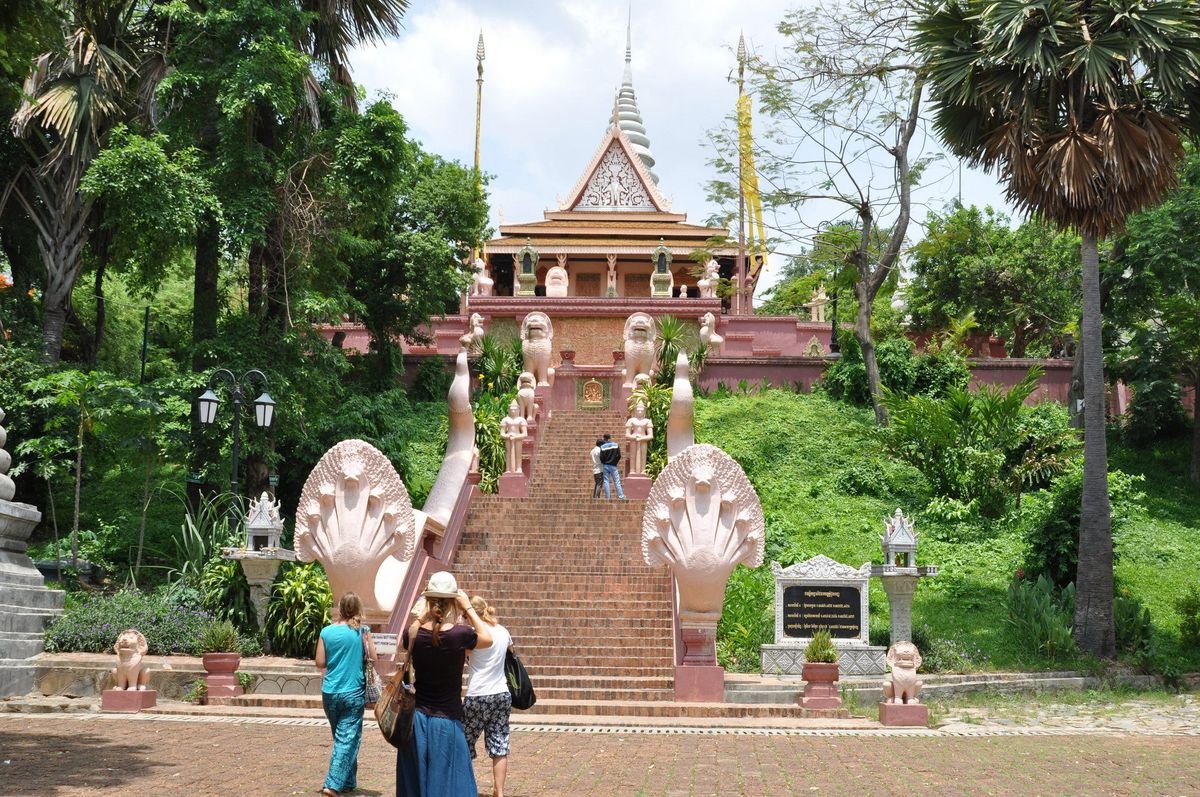About
Built in 1372, the temple of Wat Phnom stands on the only hill in Phnom Penh, which lent the the Cambodian capital its name. According to legend, the temple was originally built to house four statues of the Buddha found in a tree floating in the nearby river.
Back in 1372, or so the story goes, a wealthy widower named Daun Penh came across a fallen koki tree floating in the river near her home. Inside the tree she found four bronze statues of the Buddha. Amazed by this discovery, Penh and her neighbors built a temporary shrine on a piece of raised ground near her house. The locals called the small hill Phnom Penh, or "Penh's Hill," in her honor.
About 60 years later, King Ponhea Yat, the last king of the Khmer Empire, moved to Phnom Penh. He gave the order to increase the size of the hill, and to build a wooden temple atop it. This was the first rebuilding of Wat Phnom—one of many over the following centuries—and the remains of Ponhea Yat are still housed in a stupa behind the main temple.
The main temple was rebuilt in 1434, 1806, 1894, and 1926. Its importance rose and fell over the years, depending on the whims of kings, and extensive renovations were made to fit the ideologies of various rulers, including the Khmer Rouge and Pol Pot. New shrines and statues have been added, and the original walls plastered and painted over on numerous occasions.
Today, the temple is an amalgam of styles and structures from across its more than 600-year history, including gardens built by the French in the late 19th century and shrines that represent Taoist, Confucian, and Hindu beliefs.
The grand main entrance runs up the eastern stairway, its path guarded by lions and naga, the mythical snakes of Hinduism and Buddhism. Inside the temple sits a large bronze Buddha, the walls covered by paintings that tell his story, and murals that recount the Reamker, the Khmer version of the Ramayana.
Many more shrines dot the sides and base of the hill, but few are more important than the shrine to Daun Penh, the supposed founder of the wat. The front of her shrine is often crowded with people leaving offerings of food and praying to Daun Penh, and many women come here to pay tribute to the temple's female founder.
Other notable features include a little shrine dedicated to the spirit or genie Preah Chau, which is thought to offer protection from enemies and is especially popular among the Vietnamese community. There's also the over 200-foot-wide flower clock, originally a gift from France in the 1960s, but replaced in 2000 by a new version given as a gift by China.
Related Tags
Know Before You Go
Wat Phnom is located north of Road 102, Norodom Boulevard, in the center of Phnom Penh. It's open from 7 a.m. to 6.30 p.m. Entrance is $1, and $2 for the on-site museum. Prepare yourself for a somewhat chaotic scene when you arrive and begin the walk to the top of the hill. Pushy vendors and beggars vie for your attention, but it's easy enough to navigate; just hold on to your wallet.
You should also avoid the people selling birds in cages. Often children are the ones doing this. The idea is that you pay to have the bird released, but the birds are typically trained to return to their cages, or they die from the stress of the whole experience. To make things worse, some of the birds are endangered species.
Community Contributors
Added By
Published
September 12, 2018
Sources
- http://www.orientalarchitecture.com/sid/37/cambodia/phnom-penh/wat-phnom
- https://www.travelfish.org/sight_profile/cambodia/phnom_penh_and_surrounds/phnom_penh/phnom_penh/308
- https://www.travelfish.org/sight_profile/cambodia/phnom_penh_and_surrounds/phnom_penh/phnom_penh/308
- https://www.lonelyplanet.com/cambodia/phnom-penh/attractions/wat-phnom/a/poi-sig/441644/355881
- https://www.tourismcambodia.com/attractions/phnompenh/wat-phnom.htm

































